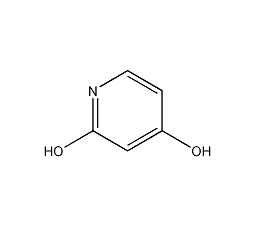
Structural formula
| Business number | 06ST |
|---|---|
| Molecular formula | C5H5NO2 |
| Molecular weight | 111.10 |
| label |
2,4-pyridinediol, 4-hydroxy-2-pyridone, 2,4-Pyridinediol, 3-Deazauracil, 4-Hydroxy-2-pyridone |
Numbering system
CAS number:626-03-9
MDL number:MFCD00006273
EINECS number:210-924-8
RTECS number:UV1146800
BRN number:108533
PubChem number:24863634
Physical property data
1. Characteristics: slightly white solid.
2. Density (g/mL,25/4℃): Undetermined
3. Relative vapor density (g/mL,Air=1): Undetermined
4. Melting point (ºC): 275-277
5. Boiling point (ºC,Normal pressure): 315
6. Boiling point (ºC,5.2kPa): Undetermined
7. Refractive Index: Undetermined
8. Flash Point (ºC): Undetermined
9. Specific optical rotation (º): Undetermined
10. Autoignition point or ignition temperature (ºC): Undetermined
11. Vapor pressure (kPa,25ºC): Undetermined
12. Saturated vapor pressure (kPa,60ºC): Undetermined
13. Heat of combustion (KJ/mol): Undetermined
14. Critical temperature (ºC): Undetermined
15. Critical pressure (KPa): Undetermined
16. Oil and water (octanol/Log value of water) partition coefficient: -1.39
17. Explosion limit (%,V/V): Undetermined
18. Lower explosion limit (%,V/V): Undetermined
19. Solubility: Not determined.
Toxicological data
1, acute toxicity: mice (peritoneal)LD50: 4,895mg/kg
Since the LD50 of table salt is 3,000 mg/kg span>, BPA has the same acute toxicity as table salt.
Ecological data
For products that are slightly harmful to water, do not let large amounts of products come into contact with groundwater, waterways or sewage systems. Do not discharge materials into the surrounding environment without government permission.
Molecular structure data
1. Molar refractive index:28.10
2. Molar Volume (cm3/mol):79.5
3. isotonic ratio (90.2K):231.4
4. Surface Tension (dyne/cm):71.7
5. Polarization Rate(10-24cm3):11.14
Compute chemical data
1. Reference value for hydrophobic parameter calculation (XlogP): -0.4
2. Number of hydrogen bond donors: 2
3. Number of hydrogen bond acceptors: 2
p>
4. Number of rotatable chemical bonds: 0
5. Number of tautomers: 9
6. Topological molecule polar surface area 49.3
7. Number of heavy atoms: 8
8. Surface charge: 0
9. Complexity: 169
10. Number of isotope atoms: 0
11. Determine the number of atomic stereocenters: 0
12. Uncertain number of atomic stereocenters: 0
13. Determine the number of chemical bond stereocenters: 0
14. Number of uncertain chemical bond stereocenters: 0
15. Number of covalent bond units: 1
Properties and stability
Keep away from oxides.
Storage��Method
Store in an airtight container in a cool, dry place. Store away from oxidizing agents.
Synthesis method
None
Purpose
None

 微信扫一扫打赏
微信扫一扫打赏

